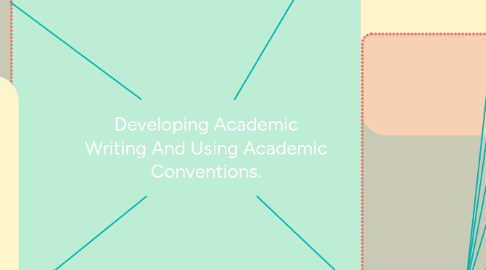Developing Academic Writing And Using Academic Conventions.
Claire Louiseにより


1. Referencing
1.1. All citations and secondary citations should be included in your reference list.
1.2. Reference list appears at the end of the piece of work.
1.3. Reference list should be in alphabetical order.
1.4. Names of organisations should not be abbreviated.
1.5. Use the Harvard Reference Guide supplied at the start of the modules.
2. Citations
2.1. Use relevant, reliable sources.
2.2. Read around the subject and put the researched information into your own words with reference to the author.
2.3. Wherever possible quote from original sources.
2.4. A citation needs an authors surname and date of publication.
2.5. The date is always in brackets, the surname is in brackets if it doesn't appear naturally within the text.
2.6. For three or more authors only the first is mentioned, followed by et al. (italics)
2.7. For an internet source the organisation is the author.
2.8. When using an edited book use the authors of the chapter not the editors.
3. Writing Style
3.1. Consider who the writer is.
3.1.1. 1ST
3.1.1.1. 2ND
3.1.1.1.1. 3RD
3.2. Avoid emotive language.
3.3. Be Impersonal.
3.4. Be objective not subjective.
3.5. Be explicit not implicit.
3.6. Use evidence.
3.7. Passive voice.
3.8. Use reasoning.
3.9. Language
3.9.1. Use eloquent English.
3.9.2. Avoid slang and colloquialisms.
3.9.3. Write in a formal manner, avoid using 'chatty phrases'.
3.9.4. Literal. Words with definitions.
4. Content
4.1. Use good Sentence Construction.
4.1.1. Simple sentences.
4.1.1.1. Compound Sentences.
4.1.1.1.1. Complex Sentences.
4.2. Even Paragraphs.
4.2.1. The last sentence on each paragraph leading onto the next paragraph topic/theme.
4.3. Stick to the word count.
4.4. Ensure Grammar, punctuation are correct avoiding abbreviations.
4.5. Answer the question and meet the learning objectives.
4.6. Use relevant material. There should be one central theme that all content should relate to.
4.7. Work should be in a logical order and flow nicely.
4.8. Simplicity
4.8.1. Clarity
4.8.1.1. Precise
4.9. Adopt a critical mind and question what the literature says.
4.9.1. Distinguishing Fact.
4.9.1.1. Opinion and Argument.
4.10. Use a wide range of sources. Always use citations when paraphrasing literature.
4.10.1. So What?
4.10.1.1. Who Said?
